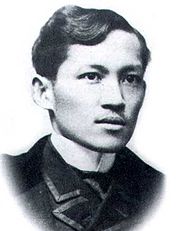
Men in the Philippines
Encyclopedia

Philippines
The Philippines , officially known as the Republic of the Philippines , is a country in Southeast Asia in the western Pacific Ocean. To its north across the Luzon Strait lies Taiwan. West across the South China Sea sits Vietnam...
, a country in South East Asia or the Far East
Far East
The Far East is an English term mostly describing East Asia and Southeast Asia, with South Asia sometimes also included for economic and cultural reasons.The term came into use in European geopolitical discourse in the 19th century,...
. This is synonymous to the phrases Filipino men
, Philippine men, Filipino males, Philippine males, men from the Philippines, men of the Philippines, and men of Philippine society.
Role models

Role model
The term role model generally means any "person who serves as an example, whose behaviour is emulated by others".The term first appeared in Robert K. Merton's socialization research of medical students...
s are primarily their father (10%) and the Philippine national hero, Jose Rizal
José Rizal
José Protacio Rizal Mercado y Alonso Realonda , was a Filipino polymath, patriot and the most prominent advocate for reform in the Philippines during the Spanish colonial era. He is regarded as the foremost Filipino patriot and is listed as one of the national heroes of the Philippines by...
(24%) (Filipino female respondents regard their mothers as their female role models).
Participation in society
Despite efforts in the Philippines to advance the status of Philippine women, particularly in relation to occurrences of gender inequalityGender inequality
Gender inequality refers to disparity between individuals due to gender. Gender is constructed both socially through social interactions as well as biologically through chromosomes, brain structure, and hormonal differences. Gender systems are often dichotomous and hierarchical; binary gender...
, there was a move in ensuring equal contribution from both men and women in the economic, social, political, cultural, and environmental development of the Philippines. The aim, according to the 2001 to 2004 Framework Plan for Women (FPW) of the Philippine Plan for Gender and Development
Gender and Development
The Gender and Development approach is a way of determining how best to structure development projects and programs based on analysis of gender relationships...
(PPGD) (which is a thirty-year plan) was to provide both genders "with equal conditions for realizing their full rights" in the country's development, and to improve the "awareness and capabilities" of both genders in participation, making decisions, powers, and control in such a development project.
Population
According to the CIA World Fact Book, which was based on a July 2001 census estimation, there were 15,547,712 Filipino males within the 0–14 years old bracket, 24,374,849 Filipino males within the 15-64 yearls old age range, and 1,355,046 Filipino males belonging to the 65 years and older age group.Family size
Based on the data gathered by NDHS in 2003, there were 22% of Filipino husbands who prefer having a large family or who wants to have a high number of offspring. This result of the survey were dependent "socio-demographic characteristics" which includes the men's age (plus age at marriage), education, employment status, poverty status, familial characteristics, duration of marriage, the number of living children.See also
- Filipino peopleFilipino peopleThe Filipino people or Filipinos are an Austronesian ethnic group native to the islands of the Philippines. There are about 92 million Filipinos in the Philippines, and about 11 million living outside the Philippines ....
- Women in the PhilippinesWomen in the PhilippinesThe role of women in the Philippines is explained based on the context of Filipino culture, standards, and mindsets. The Philippines is described to be a nation of strong women, who directly and indirectly run the family unit, businesses, government agencies and haciendas.Although they generally...
- Demographics of the PhilippinesDemographics of the PhilippinesDemographics of the Philippines are records of human population in the country, including its population density, ethnicity, education level, health, economic status, religious affiliations, and other aspects of the population. According to the 2007 Census, the population of the Philippines was...
- Ethnic groups in the PhilippinesEthnic groups in the PhilippinesThe Philippine islands are inhabited by number of different ethnic groups. The majority of the population is composed of ethnolinguistic groups whose languages are Austronesian in origin. Many of these groups converted to Christianity, and adopted many foreign elements of culture...
- Courtship in the PhilippinesCourtship in the PhilippinesTraditional courtship in the Philippines is described as a "far more subdued and indirect" approach compared to Western or Westernized cultures. It involves "phases" or "stages" inherent to Philippine society and culture. Evident in courtship in the Philippines is the practice of singing romantic...
- Filipino psychology
- Filipino valuesFilipino valuesThe Filipino value system or Filipino values refers to the set of values or the value system that a majority of Filipino people have historically held important in their lives. This Philippine value system includes their own unique assemblage of consistent ideologies, moral codes, ethical...
External links
- Photographs of Filipino men from jacobimages.com
- Advincula, Anthony D. Profile of the New Filipino Family: House-Husbands Watch the Home Front While Women Fill U.S. Demand for Nurses, New America Media, Immigration, September 25, 2009, alternet.org
- The Filipino Male and His Ego, houseonahill.net
- LaHoz, Mila. My Problem, My Husband, A Filipino mother explains why her husband clings to "Filipino macho values, newint.org, July 1980
- Dumanig, Francisco Perlas. Phonological Differences of (f) and (v) Among Young Filipino Male and Female Students, ecampus.inti.edu.my
- Naraval, Camilo A.B. Filipino Masculinity, a documented presented as slides (click on page-down/page-up keys/buttons to change pages or place cursor at middle of page then left-click your computer's mouse), Health and Management Research Group, asienhaus.de

